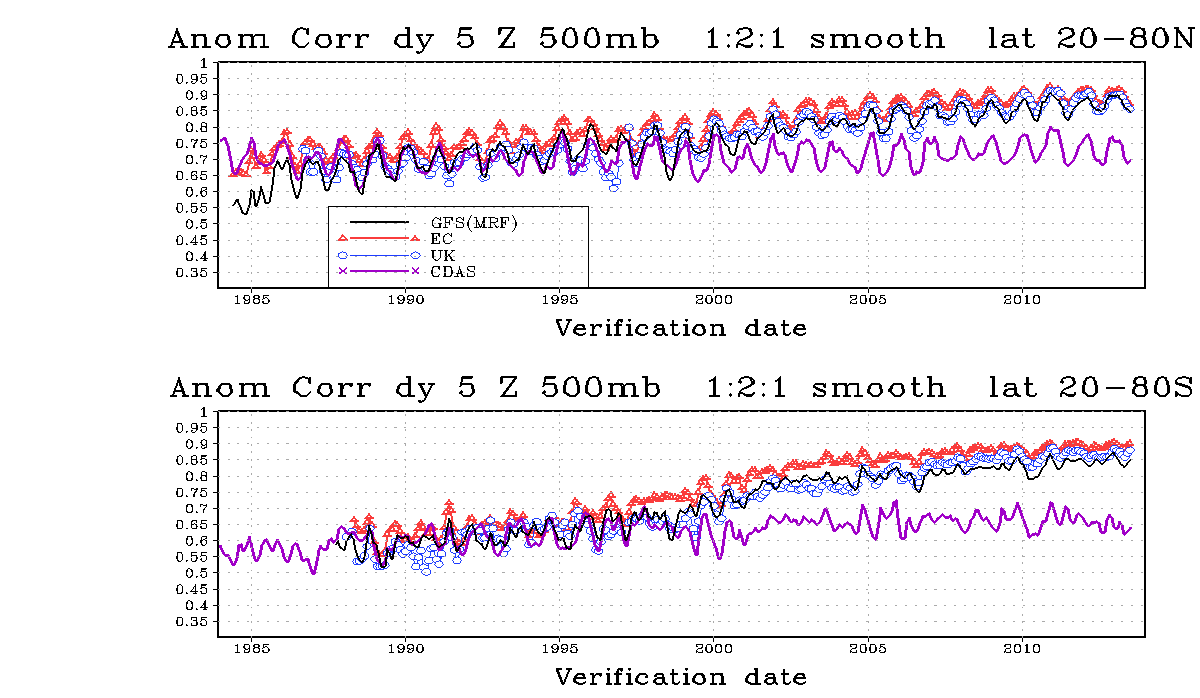PG-Conditions-Reporter KarlNickel fragt: „Ich nehme an, (die Vorhersageunsicherheit) ist vor allem auf die große Menge an Daten und Parametern zurückzuführen, die rechnerisch schwer zu erfassen ist? Mich würde mal interessieren, ...ob man etwa in 10 Jahren auch zuverlässige 7tages Prognosen treffen kann.“ Die moderne Wettervorhersage ist in ihren Orakelkapazitäten durch verschiedene Faktoren eingeschränkt:
Die Datengrundlage
Ein Wettermodell braucht einen Anfangszustand, von dem aus es in die Zukunft rechnet. Wenn es nicht weiß, wie das Wetter heute ist, kann es nichts über das Wetter von morgen sagen. Am ECMWF (European Center for Medium Range Weather Forecasts) werden täglich etwa 8 Millionen Beobachtungsdatenpunkte verarbeitet. Diese Informationen stammen u.a. von Bodenwetterstationen, Schiffen, Bojen, Flugzeugen und Satelliten und kommen aus der ganzen Welt. Oft sind fehlerhafte Daten dabei, überall wird irgendwie unterschiedlich gemessen und naturgemäß gibt es mehr Daten aus Ballungsräumen als aus der Sahara oder vom Nordpol. Es muss also erstmal einige Arbeit in Qualitätskontrolle und räumliche und zeitliche Interpolation investiert werden, bis wir unserem Modell einen einigermaßen brauchbaren Anfangszustand präsentieren können.
Rechenkapazitäten
Wir haben nun also einen riesigen Datenhaufen, auf den wir diverse, nicht ganz unkomplexe Berechnungen anwenden wollen. Ach ja, und dann müssen wir auch noch die Topographie berücksichtigen, weil wir ja den Arlberg im Modell brauchen, um zu sehen ob es dort Nordstau gibt. Das können wir jetzt alles ausrechnen, aber auch die leistungsfähigsten Supercomputer sind ganz einfach zu langsam, um immer die best mögliche Auflösung zu rechnen und zeitnah damit fertig zu werden. Wir müssen uns also entscheiden, ob wir kleinräumige, hoch aufgelöste Vorhersagen für einen kurzen Zeitraum wollen, oder gröbere Vorhersagen für längere Zeit. Manche Leute behaupten, dass man auch heute schon durchaus eine fast perfekte 24 Stunden Vorhersage hin bekommen würde, allerdings würde die Berechnung zwei Tage dauern, was dann halt auch nichts mehr bringt.
Das Chaos
Die Atmosphäre der Erde ist ein chaotisches System. Das heißt nicht, dass es gar keine Regeln gibt, aber es setzt der numerischen Vorhersage gewisse theoretische und praktische Grenzen. Deterministisches Chaos bedeutet, dass das System
- sehr sensibel auf kleinste Änderungen der Anfangsbedingungen reagiert
- und entsprechende Fehler exponentiell wachsen.
- Das System ist nicht periodisch, das heißt ein bestimmter Zustand wiederholt sich nie genau.
- Lokale Instabilität bei globaler Stabilität. Kleinsträumige Veränderungen des Systems sind nicht vorhersagbar, großräumige aber schon.
Das Verhalten des Systems ist nicht zufällig, sondern eben in diesem Sinn chaotisch. Man kann sich das ganze vorstellen, wie ein Skibag, in das man nicht nur Ski und Stöcke packt, sondern in das man auch noch den ganzen wichtigen Kleinkram stopft, vom Blasenpflaster bis zum Schraubenzieher. Bevor wir das Bag schließlich zumachen, wissen wir ziemlich genau, wo alles ist. Dann geben wir es beim Sperrgepäck auf und sehen es erst einen Langstreckenflug später wieder. Je nachdem, wie viel Platz noch im Bag war, wie zärtlich die Gepäckleute und wie turbulent der Flug war, kann sich die Position des Schraubenziehers komplett verändert haben und wir wissen nur, dass er (hoffentlich) immer noch irgendwo im Bag ist. Die Ski bleiben allerdings aufgrund der Randbedingungen (= Ausmaße des Bags) mehr oder weniger an der gleichen Stelle und es werden sich auch nicht plötzlich in ein Fahrrad verwandelt haben.
Also…
Ja, es ist schon möglich, dass wir in 10 Jahren eine gute 7 Tage Vorhersage haben. Dafür brauchen wir schnellere Computer und bessere Anfangsbedingungen (Beobachtungsdaten). Es wird trotzdem noch bessere und schlechtere Vorhersagen geben, je nach Wetterlage (wenn wir Erster Klasse mit dem Zug von Innsbruck nach St Anton fahren, wird sich der Schraubenzieher im Skibag tendenziell weniger bewegen, als wenn wir von Buxtehude nach Srinagar fliegen und fünf mal umsteigen), und komplett perfekt werden die Vorhersagen wohl nie werden.
Abschließend noch zur aktuellen Lage:
PG-Leser No Friends on Powder Days fragt: Gibt es trotz dem „ominösen Omega/Polarwirbelsplit-Ding“ noch Hoffnung? Nunja, das Omega Ding ist wie ein komplett vollgestopftes Skibag auf einer ruhigen Zugfahrt – da bewegt sich ziemlich sicher ziemlich wenig. Die Modelle zeigen gegen Ende der Mittelfrist immer mal wieder irgendwelche Variationen, durch die sich die Gorßwetterlage ändern könnte, von einem langsamen nach Osten rutschen des Tiefs im Atlantik und resultierender Süd-West Lage bis zu einer Abschwächung des Omegahochs und nachlassender Blockade. Das liegt aber wie gesagt eher im Glaskugelbereich. Erstmal sollte man sich definitiv auf Sonne in den Bergen und Hochnebel im Flachland einstellen.






